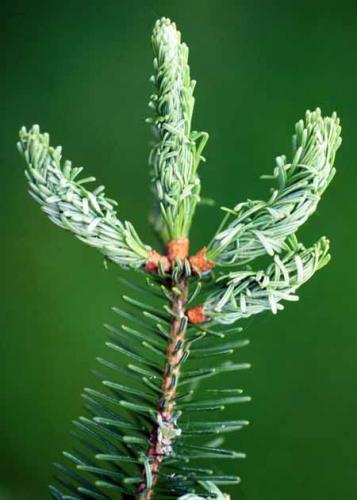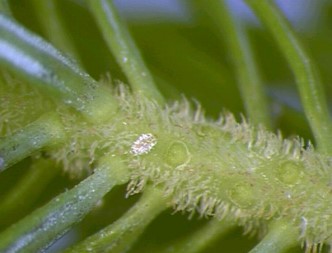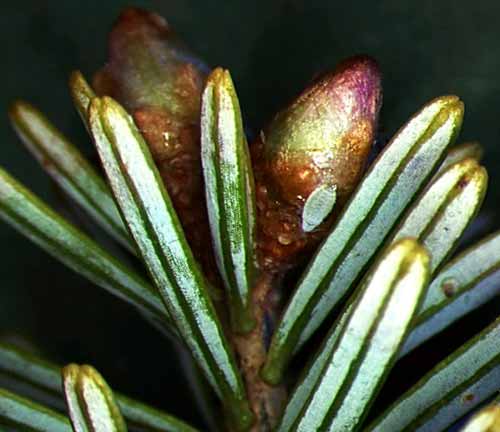Target stem mothers to control balsam twig aphids in Christmas trees
Targeting the stem mothers is the key to preventing curling and distortion of new growth caused by balsam twig aphid.

Feeding by balsam twig aphid (Mindarus abietinus Koch) will cause current-year needles that are expanding to bend or curl. When aphid levels are low, damage is hardly noticeable. However, when aphid densities are high, current year needles become severely distorted and appear to be curled or wrapped around the shoot. When this level of damage occurs, needle growth may be reduced, causing the current year shoots to appear stunted. Balsam twig aphids rarely kill trees, but reduced tree growth and appearance can decrease tree value.

Balsam twig aphid eggs begin to hatch early in the spring. Egg hatch is usually completed in one to two weeks.

Studies by Michigan State University Extension forest entomologist Deb McCullough show that egg hatch begins at roughly 60 to 70 growing degree days (GDD) base 50 degrees Fahrenheit and continues until approximately 100 GDD50. Newly hatched aphids are very small and difficult to see, but by approximately 100 to 140 GDD50 they are large enough to be easily visible against a dark background. These first generation aphids are called “stem mothers.”

When spraying is necessary, apply insecticides at the proper time to prevent damage to current year foliage. The ideal time to spray is at 100 to 140 GDD50. Typically at this point, buds are swelling but have not yet broken and the stem mothers have hatched but are still maturing. These stem mothers are also relatively exposed at the ends of the shoots. Controlling the stem mothers is important because the second generation of aphids, called sexuparae, cause the damage to the current year needles. Most sexuparae feed inside the expanding buds where they are protected from insecticides.
If your Fraser or balsam fir trees were heavily damaged by this aphid last year, get out and do your scouting right away. Check the trees with damage from last year – that is where you will most likely find aphids this year. If you had heavy damage last summer and are planning to harvest trees this year, apply an insecticide this spring. To prevent damage to your trees, you will need to kill the stem mother – this first generation.
Keep in mind, however, that if aphid populations are not very high and you did not have heavy damage last year, you don't need to spray. Trees can outgrow some of the damage by mid or late summer. Plus, there are many insect predators and tiny parasitoid wasps that will attack balsam twig aphids.
For more information, see McCullough’s Balsam Twig Aphid YouTube video, or the MSU Extension bulletin “Biology and Management of Balsam Twig Aphid” (E2813).



 Print
Print Email
Email




